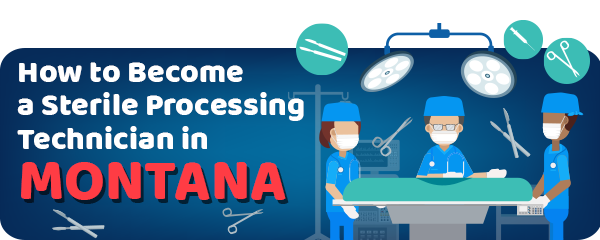The healthcare industry offers an excellent work environment known for its stability compared to other fields.
One potential career path within this industry is that of a sterile processing technician.
If you’re considering this profession, it’s important to familiarize yourself with the necessary requirements.
Below, we will outline the steps to becoming a sterile processing technician in Montana.
Article Table of Contents
Job Duties and Skills of Sterile Processing Technicians in Montana
In Montana, obtaining a license is not a requirement for your first job, which is generally the case in most U.S. states, with a few exceptions.
However, it is still recommended to pursue certification.
While many medical facilities hire sterile processing technicians without a license, most prefer candidates with experience.
Therefore, having certification demonstrates that you possess the necessary skills and knowledge to perform the job effectively.
The daily responsibilities of a sterile processing technician typically include:
- Conducting inventory checks.
- Managing and monitoring the prevention of illness and infection.
- Cleaning, sterilizing, packaging, and storing medical tools.
- Maintaining and repairing medical equipment.
- Adhering to protocols and specific methods for appropriate disinfection and sterilization of medical tools and equipment.
Developing additional skills can be beneficial for this role, such as:
- Strong organizational abilities
- Problem-solving aptitude specific to the position
- Knowledge of medical terminology
- A thorough understanding of aseptic techniques
It’s worth noting that job tasks and required skills may vary depending on the employer.
How to Become a Sterile Processing Technician in Montana
Obtaining certification as a sterile processing technician is a process with several pathways you can follow to achieve your goal.
The easiest option is to take and pass the three-hour national certification exam.
Several organizations offer certification exams in Montana, such as the Healthcare Sterile Processing Association (HSPA), which provides five levels of licensing, but the entry level is sufficient.
Following that, you will need to take the Certified Registered Central Service Technician (CRCST) certification exam.
Another approach is to obtain certification through the Certification Board for Sterile Processing and Distribution (CBSPD).
This requires passing the test and having 12 months of prior experience.
Additional requirements include:
- Completing approximately 400 hours of lab practice
- Submitting a fee
- Holding a high school diploma or GED
- Passing a background check and drug test
- Passing the licensing exam.
The practice part of the program should break down the hours:
- Decontamination procedures – 120 hours
- Disinfection and sterilization – 96 hours
- Instrument packaging and preparation – 120 hours
- Quality assurance procedures – 24 hours
- Storage and distribution – 24 hours
- Surgical and medical equipment – 16 hours
It’s important to remember that your sterile processing technician certification requires annual renewal. You may also consider attending extra classes and workshops to stay updated on industry changes.
Training Programs for Sterile Processing Technicians in Montana
Enrolling in a school that offers a sterile processing technician program is highly recommended for optimal results.
Such a program will provide you with the knowledge and hands-on experience required for certification.
In Montana, there are several schools that offer sterile processing technician programs. Below, you can find more information about these educational institutions.
Allied Health (Yakima Valley College) 
This program is ideal for everyone looking to work in the medical industry.
It will teach you all the things you need to know to become a sterile processing assistant.
Furthermore, it also prepares you for other jobs in the healthcare field.
The program lasts for 2 quarters and includes lab hours and hands-on practice in medical facilities.
The course starts every fall, and it is customized to fit every student.
This program also provides the following:
- Using and maintaining surgical tools and devices, patient care equipment, and other medical equipment.
- Online classes, with hands-on and lab hours
- A 400-hour clinical externship
- The chance to start your career in only half a year.
- Opportunity grants after your application got approved
- Qualification to take the national HSPA certification exam
University of Montana 
This is another school that offers a sterile processing technician program.
The program prepares you for the national exam and offers:
- A comprehensive introduction to the core principles and responsibilities of a sterile processing technician in the healthcare setting
- In-depth understanding of medical terminology, infection control, and the proper sterilization of medical and surgical instruments
Proficiency in:
- Managing medical inventory
- Surgical technology
- Equipment maintenance in various departments, including operating rooms
- Familiarization with the processes and procedures in hospitals
- Participation in hands-on clinical training
- A chance to get grants and vouchers to support educational pursuits
- Preparation and qualification for taking the national HSPA certification exam through the provided education
| School Name | Address |
|---|---|
| Yakima Valley College | W Nob Hill Blvd &, S 16th Ave, Yakima, WA 98902 |
| University of Montana | 32 Campus Dr, Missoula, MT 59812 |
Sterile Processing Technician Salaries in Montana
After obtaining your license, finding employment as a sterile processing technician should be relatively easy, given your certification and work experience.
Various healthcare facilities hire sterile processing technicians, including hospitals, laboratories, doctor’s offices, clinics, and dentist practices.
If you’re curious about the potential earnings as a sterile processing technician, salaries in Montana average around $42,000 per year and $20 per hour.
However, several factors influence the actual salary, such as your level of experience.
The more experience you have in the field, the higher your pay is likely to be.
Additionally, the medical field offers promising opportunities for career advancement.
Annual Salary Range:| Location | Avg. Annual Salary |
|---|---|
| Billings | $44,148 |
| Kalispell | $41,098 |
| Great Falls | $40,417 |
| Helena | $39,444 |
| Missoula | $38,755 |
| Bozeman | $38,755 |
| Butte | $38,755 |
| Belgrade | $38,755 |
| Anaconda | $38,755 |
| Darby | $38,755 |
Regional Salary in Montana
| Region | Employed | Avg. Annual Salary | Avg. Hourly Pay | Top 10% Annual Salary | Bottom 10% Annual Salary |
|---|---|---|---|---|---|
| Billings, MT | 110 | $42,480 | $20.42 | $57,430 | $31,520 |
| Missoula, MT | 30 | $44,150 | $21.23 | $58,460 | $37,480 |
* Employment conditions in your area may vary.
Frequently Asked Questions
How do the salaries for sterile processing technicians in Montana compare to the salaries in other states, for the same position?
Considering that the median income for this occupation in Montana is around $42,000 per year and that at the national level, the median income is around $43,000 per year, you could say the difference is not big.
Are there many sterile processing technician jobs available in Montana?
There are plenty of job openings for these professionals in this state and the trend is expected to increase.
Can I earn a degree before becoming a sterile processing technician in Montana?
Yes, however, the degree would have to be earned in a different state.
All degrees for this position are at the Associate’s level.
Read the full guide: How to Become a Sterile Processing Technician


